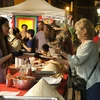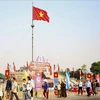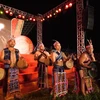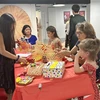 An aerial view of the ancient Vietnam National Museum of History which is adorned with the red flowers of a giant bombax ceiba tree for the month of March. The museum was established under Decision No. 1674/QD-TTg dated September 2011 by the Prime Minister on the basis of the amalgamation of the National Museum of Vietnamese History and the National Museum of the Vietnamese Revolution. The Museum is located in the heart of Hanoi close to many sacred relics, a place to preserve, display, and introduce Vietnamese history through a system of rich and valuable documents and artefacts, including many National Treasures. (Photo: VietnamPlus)
An aerial view of the ancient Vietnam National Museum of History which is adorned with the red flowers of a giant bombax ceiba tree for the month of March. The museum was established under Decision No. 1674/QD-TTg dated September 2011 by the Prime Minister on the basis of the amalgamation of the National Museum of Vietnamese History and the National Museum of the Vietnamese Revolution. The Museum is located in the heart of Hanoi close to many sacred relics, a place to preserve, display, and introduce Vietnamese history through a system of rich and valuable documents and artefacts, including many National Treasures. (Photo: VietnamPlus)  A closer look at the red-flowered bombax ceiba tree at the museum. The construction of the building started in 1929 and completed three years later on an area behind the Hanoi Opera House that runs along the Red River dyke. The building is the finishing point of the Quaï Guillemoto (now Tran Quang Khai street), which is a highlight along the road against the dyke. Upon arrival at the museum, visitors will experience outstanding representations of the history and culture of Vietnam as well as the heroic tradition of the Vietnamese people formed during the process of national construction and defence. (Photo: VietnamPlus)
A closer look at the red-flowered bombax ceiba tree at the museum. The construction of the building started in 1929 and completed three years later on an area behind the Hanoi Opera House that runs along the Red River dyke. The building is the finishing point of the Quaï Guillemoto (now Tran Quang Khai street), which is a highlight along the road against the dyke. Upon arrival at the museum, visitors will experience outstanding representations of the history and culture of Vietnam as well as the heroic tradition of the Vietnamese people formed during the process of national construction and defence. (Photo: VietnamPlus)  A group of children join a sightseeing tour at the Vietnam National Museum of History held while the red bombax ceiba flowers are in bloom. The flowers blossom only for a few weeks in March. During the period, the museum joins hands with the Hanoitourist travel company to offer a tour for visitors to take photos with the flowers and explore the museum. Ticket price for one adult is 75,000 VND (about 3.3 USD) while it is one third of that price for a child. The museum is a place to preserve, display, and introduce the history of Vietnam from prehistoric to present. (Photo: VietnamPlus)
A group of children join a sightseeing tour at the Vietnam National Museum of History held while the red bombax ceiba flowers are in bloom. The flowers blossom only for a few weeks in March. During the period, the museum joins hands with the Hanoitourist travel company to offer a tour for visitors to take photos with the flowers and explore the museum. Ticket price for one adult is 75,000 VND (about 3.3 USD) while it is one third of that price for a child. The museum is a place to preserve, display, and introduce the history of Vietnam from prehistoric to present. (Photo: VietnamPlus)  Red bombax ceiba flowers at the entrance to the grand building of the museum in the background. The building has an octagonal shape, with each side extending up to 11 metres. Meanwhile, the exhibition zone is located behind the hall and the rooms are connected, thereby creating a sense of transition between periods. Thematic exhibition zones are on both sides of the grand hall. Bombax ceiba, commonly known as red silk-cotton tree, is a large, spiny and deciduous tree. This tree starts dropping its leaves each year in January-February in anticipation of flowering (March-April). Flowers begin appearing when the tree is leafless. The ground becomes littered with fallen petals during the month of bloom. (Photo: VietnamPlus)
Red bombax ceiba flowers at the entrance to the grand building of the museum in the background. The building has an octagonal shape, with each side extending up to 11 metres. Meanwhile, the exhibition zone is located behind the hall and the rooms are connected, thereby creating a sense of transition between periods. Thematic exhibition zones are on both sides of the grand hall. Bombax ceiba, commonly known as red silk-cotton tree, is a large, spiny and deciduous tree. This tree starts dropping its leaves each year in January-February in anticipation of flowering (March-April). Flowers begin appearing when the tree is leafless. The ground becomes littered with fallen petals during the month of bloom. (Photo: VietnamPlus)  Visitors go for a stroll at the Vietnam National Museum of History, with the bombax ceiba tree in the background. Formerly known as Louis Finot Museum, it is a marvellous architectural work which sees the harmonious combination of Vietnamese, Japanese, Thai and Chinese styles. At present, the Museum has two permanent exhibitions at two different locations. The first one is at No.1 Trang Tien street in downtown Hanoi, introducing the history of Vietnam from prehistory to the end of the Nguyen Dynasty (1945); and the latter at No. 216 Tran Quang Khai Street nearby, telling the history of Vietnam from the mid-19th century to present. (Photo: VietnamPlus)
Visitors go for a stroll at the Vietnam National Museum of History, with the bombax ceiba tree in the background. Formerly known as Louis Finot Museum, it is a marvellous architectural work which sees the harmonious combination of Vietnamese, Japanese, Thai and Chinese styles. At present, the Museum has two permanent exhibitions at two different locations. The first one is at No.1 Trang Tien street in downtown Hanoi, introducing the history of Vietnam from prehistory to the end of the Nguyen Dynasty (1945); and the latter at No. 216 Tran Quang Khai Street nearby, telling the history of Vietnam from the mid-19th century to present. (Photo: VietnamPlus)  The octagonal building of the museum is adorned with the bright colour of red silk-cotton flowers. The tree starts dropping its leaves each year in January-February in anticipation of flowering (between March and April). Flowers begin appearing when the tree is leafless. New leaves appear only after almost all of the flowering is completed (typically by April). Flowers are followed by seed pods which split open in April and May to release to the wind large quantities of silky cotton embedded with small brown seeds. The Vietnam National Museum of History stores and preserves about 200,000 objects and materials of Vietnamese cultural history. There are nearly 110,000 antiques and 20 national treasures from prehistory to 1945. There are rare and valuable collections representing the history and culture of Vietnam. (Photo: VietnamPlus)
The octagonal building of the museum is adorned with the bright colour of red silk-cotton flowers. The tree starts dropping its leaves each year in January-February in anticipation of flowering (between March and April). Flowers begin appearing when the tree is leafless. New leaves appear only after almost all of the flowering is completed (typically by April). Flowers are followed by seed pods which split open in April and May to release to the wind large quantities of silky cotton embedded with small brown seeds. The Vietnam National Museum of History stores and preserves about 200,000 objects and materials of Vietnamese cultural history. There are nearly 110,000 antiques and 20 national treasures from prehistory to 1945. There are rare and valuable collections representing the history and culture of Vietnam. (Photo: VietnamPlus)  A visitor walks through the entrance of the octagonal building of the museum. With a fitting combination of Asian and European architectural styles, there is harmony created between the museum and natural landscape. The main building of the Vietnam National Museum History is among major representatives of the Indochine architectural style in Hanoi in particular and Vietnam at large. It stores about 200,000 objects and materials of Vietnamese cultural history. There are rare and valuable collections representing the history and culture of Vietnam. The museaum is a member of the International Council of Museums, the founding member of the Asian National Museums Association. (Photo: VietnamPlus)
A visitor walks through the entrance of the octagonal building of the museum. With a fitting combination of Asian and European architectural styles, there is harmony created between the museum and natural landscape. The main building of the Vietnam National Museum History is among major representatives of the Indochine architectural style in Hanoi in particular and Vietnam at large. It stores about 200,000 objects and materials of Vietnamese cultural history. There are rare and valuable collections representing the history and culture of Vietnam. The museaum is a member of the International Council of Museums, the founding member of the Asian National Museums Association. (Photo: VietnamPlus)  A space dedicated to Bac Co Village in the museum. The name Bac Co bears a slight resemblance to the former name of the museum. The Louis Finot Museum was previously part of the École Française d’Extrème Orient school designed by architects C.Batteur and E.Hebrand in 1925. At present, the VNMH has two permanent exhibitions at two different locations. The first one is at No.1 Trang Tien street in downtown Hanoi, introducing the history of Vietnam from prehistory to the end of the Nguyen Dynasty (1945); and the latter at No.216 Tran Quang Khai Street nearby, telling the history of Vietnam from the mid-19th century to present. (Photo: VietnamPlus)
A space dedicated to Bac Co Village in the museum. The name Bac Co bears a slight resemblance to the former name of the museum. The Louis Finot Museum was previously part of the École Française d’Extrème Orient school designed by architects C.Batteur and E.Hebrand in 1925. At present, the VNMH has two permanent exhibitions at two different locations. The first one is at No.1 Trang Tien street in downtown Hanoi, introducing the history of Vietnam from prehistory to the end of the Nguyen Dynasty (1945); and the latter at No.216 Tran Quang Khai Street nearby, telling the history of Vietnam from the mid-19th century to present. (Photo: VietnamPlus)  Visitors, including parents with children, go for a sight-seeing tour at the museum. They are inspired by wonderful cultural values in daily life in rural areas of Vietnam through valuable exhibits at the museum, including Ngoc Lu drum, Van Ban pagoda bell, and Tu Ky pagoda plant, among others. Formerly known as Louis Finot Museum, it is a marvellous architectural work which sees the harmonious combination of Vietnameses, Japanese, Thai and Chinese styles. At present, the VNMH has two permanent exhibitions at two different locations. The first one is at No.1 Trang Tien street in downtown Hanoi, and the latter at No.216 Tran Quang Khai Street nearby. (Photo: VietnamPlus)
Visitors, including parents with children, go for a sight-seeing tour at the museum. They are inspired by wonderful cultural values in daily life in rural areas of Vietnam through valuable exhibits at the museum, including Ngoc Lu drum, Van Ban pagoda bell, and Tu Ky pagoda plant, among others. Formerly known as Louis Finot Museum, it is a marvellous architectural work which sees the harmonious combination of Vietnameses, Japanese, Thai and Chinese styles. At present, the VNMH has two permanent exhibitions at two different locations. The first one is at No.1 Trang Tien street in downtown Hanoi, and the latter at No.216 Tran Quang Khai Street nearby. (Photo: VietnamPlus)  Visitors listen to a guide who is giving an explanation on national treasures. So far, a total of 164 artefacts have been recognised as national treasures in Vietnam.
Visitors listen to a guide who is giving an explanation on national treasures. So far, a total of 164 artefacts have been recognised as national treasures in Vietnam.The Vietnam National Museum of History is a public service unit under the Ministry of Culture, Sports and Tourism, which is at the forefront of the system of Vietnam's history-society museums. The Museum has the function of researching, collecting, storing, and displaying the value of documents and artefacts related to the Vietnamese historical process. In addition, the Museum also organises activities for training, consulting, and assessing services within the scope of museum operation. (Photo: VietnamPlus)
 Visitors take a closer look at a stone bridge which is assembled from massive pieces of rock without the use of any adhesive. After more than half a century of operation, all of the resources of the former National Museum of Vietnamese History and the National Museum of the Vietnamese Revolution have been merged into a unique museum - the VNMH. The resources include practical knowledge and experience in museum activities as well as precious collections dating from prehistory to the present. Among these collections, there are many national treasures and rare and valuable items such as a gold decree, a national seal, gold sword, Dong Son cultural collection, Champa cultural collection, the Vietnam ceramic collection, and more. (Photo: VietnamPlus)
Visitors take a closer look at a stone bridge which is assembled from massive pieces of rock without the use of any adhesive. After more than half a century of operation, all of the resources of the former National Museum of Vietnamese History and the National Museum of the Vietnamese Revolution have been merged into a unique museum - the VNMH. The resources include practical knowledge and experience in museum activities as well as precious collections dating from prehistory to the present. Among these collections, there are many national treasures and rare and valuable items such as a gold decree, a national seal, gold sword, Dong Son cultural collection, Champa cultural collection, the Vietnam ceramic collection, and more. (Photo: VietnamPlus)  Visitors can choose a sample to focus on making a sketch or painting colours for drawings in a corner of the ancient and solemn museum, in order to capture the charming images of Bombax ceiba, commonly known as red silk-cotton tree. The flowers blossom only for a few weeks in March. During the period, the museum joins hands with the Hanoitourist travel company to offer a tour for visitors to take photos with the flowers and explore the museum. The tree starts dropping its leaves each year in January-February in anticipation of flowering (between March and April). New leaves appear only after almost all of the flowering is completed (typically by April). (Photo: VietnamPlus)
Visitors can choose a sample to focus on making a sketch or painting colours for drawings in a corner of the ancient and solemn museum, in order to capture the charming images of Bombax ceiba, commonly known as red silk-cotton tree. The flowers blossom only for a few weeks in March. During the period, the museum joins hands with the Hanoitourist travel company to offer a tour for visitors to take photos with the flowers and explore the museum. The tree starts dropping its leaves each year in January-February in anticipation of flowering (between March and April). New leaves appear only after almost all of the flowering is completed (typically by April). (Photo: VietnamPlus)  Visitors listen to a guide speaking about the history and architecture of the Vietnam National Museum of History. The museum was established on the basis of the amalgamation of the former National Museum of Vietnamese History and the National Museum of the Vietnamese Revolution. It was founded on the material facilities of the Louis Finot Museum - a museum belonging to the École Française d’Extrême-Orient which was built in 1926 and inaugurated in 1932. In 1958, the Vietnam Government officially took over this cultural institution and converted the exhibition contents from eastern arts into national history. In September 1958, the museum was officially opened for visitors. (Photo: VietnamPlus)
Visitors listen to a guide speaking about the history and architecture of the Vietnam National Museum of History. The museum was established on the basis of the amalgamation of the former National Museum of Vietnamese History and the National Museum of the Vietnamese Revolution. It was founded on the material facilities of the Louis Finot Museum - a museum belonging to the École Française d’Extrême-Orient which was built in 1926 and inaugurated in 1932. In 1958, the Vietnam Government officially took over this cultural institution and converted the exhibition contents from eastern arts into national history. In September 1958, the museum was officially opened for visitors. (Photo: VietnamPlus)  On weekends, a large number of families travel to the museum and take photos with the blooming Bombax ceiba, or red silk-cotton tree. As the head of the museum system in Vietnam, the VNMH has adjusted and oriented its activities to meet the social demands and has initially achieved remarkable results in professional fields. The exhibition system is always updated with new information and materials. It is also perfected for both scientific content and display methods. The museum combines the application of modern scientific means to bring the best effect and satisfy increasing demand from the public. The museum also houses collections from China, Japan, Thailand, India, Myanmar. (Photo: VietnamPlus)
On weekends, a large number of families travel to the museum and take photos with the blooming Bombax ceiba, or red silk-cotton tree. As the head of the museum system in Vietnam, the VNMH has adjusted and oriented its activities to meet the social demands and has initially achieved remarkable results in professional fields. The exhibition system is always updated with new information and materials. It is also perfected for both scientific content and display methods. The museum combines the application of modern scientific means to bring the best effect and satisfy increasing demand from the public. The museum also houses collections from China, Japan, Thailand, India, Myanmar. (Photo: VietnamPlus)  A visitor looks at a painting of the museum in the 20th century, which is part of an outdoor exhibition. The National Museum of Vietnam History was founded on the material facilities of the Louis Finot Museum - a museum belonging to the École Française d’Extrême-Orient which was built in 1926 and inaugurated in 1932. In 1958, the Vietnam Government officially took over this cultural institution and converted the exhibition contents from eastern arts into national history. On September 3, 1958, the National Museum of Vietnam History was officially opened for visitors. The National Museum of the Vietnamese Revolution was originally the Department of Indochinese Commerce that was built in 1917 under French rule. (Photo: VietnamPlus)
A visitor looks at a painting of the museum in the 20th century, which is part of an outdoor exhibition. The National Museum of Vietnam History was founded on the material facilities of the Louis Finot Museum - a museum belonging to the École Française d’Extrême-Orient which was built in 1926 and inaugurated in 1932. In 1958, the Vietnam Government officially took over this cultural institution and converted the exhibition contents from eastern arts into national history. On September 3, 1958, the National Museum of Vietnam History was officially opened for visitors. The National Museum of the Vietnamese Revolution was originally the Department of Indochinese Commerce that was built in 1917 under French rule. (Photo: VietnamPlus)  Visitors rest at a little street stall which is set up under the red bombax ceiba tree and reminds people of the peaceful scenery in the countryside. The flowers blossom only for a few weeks in March. During the period, the museum joins hands with the Hanoitourist travel company to offer a tour for visitors to take photos with the flowers and explore the museum. Ticket price for one adult is 75,000 VND (about 3.3 USD) while it is one-third of that price for a child. The museum is a place to preserve, display, and introduce the history of Vietnam from prehistoric to present. (Photo: VietnamPlus)
Visitors rest at a little street stall which is set up under the red bombax ceiba tree and reminds people of the peaceful scenery in the countryside. The flowers blossom only for a few weeks in March. During the period, the museum joins hands with the Hanoitourist travel company to offer a tour for visitors to take photos with the flowers and explore the museum. Ticket price for one adult is 75,000 VND (about 3.3 USD) while it is one-third of that price for a child. The museum is a place to preserve, display, and introduce the history of Vietnam from prehistoric to present. (Photo: VietnamPlus)  A close look at traditional snacks in rural areas of Vietnam, particularly sweet potatoes, boiled eggs and fresh fruits, to name but a few. The Vietnam National Museum of History is a public service unit under the Ministry of Culture, Sports and Tourism, which is at the forefront of the system of Vietnam's history-society museums. The Museum has the function of researching, collecting, and displaying the value of documents and artefacts related to the Vietnamese historical process. In addition, the Museum also organises activities for training, consulting, and assessing services within the scope of museum operation. Exhibits have also been set up that relate to living utensils and labour tools of Vietnamese people in the twentieth century. (Photo: VietnamPlus)
A close look at traditional snacks in rural areas of Vietnam, particularly sweet potatoes, boiled eggs and fresh fruits, to name but a few. The Vietnam National Museum of History is a public service unit under the Ministry of Culture, Sports and Tourism, which is at the forefront of the system of Vietnam's history-society museums. The Museum has the function of researching, collecting, and displaying the value of documents and artefacts related to the Vietnamese historical process. In addition, the Museum also organises activities for training, consulting, and assessing services within the scope of museum operation. Exhibits have also been set up that relate to living utensils and labour tools of Vietnamese people in the twentieth century. (Photo: VietnamPlus)  Two young female visitors take photos of red bombax ceiba flowers falling onto the ground of the Vietnam National Museum of History. The falling flowers create a colourful scenery for commemorative photos. The tree is commonly known as red silk-cotton tree, bombax ceiba is a large, spiny and deciduous tree. This tree starts dropping its leaves each year in January-February in anticipation of flowering (March-April). Flowers begin appearing when the tree is leafless. The ground becomes littered with fallen petals during the month of bloom. Formerly known as Louis Finot Museum, the Vietnam Museum of National History is a marvellous architectural work which sees the harmonious combination of Vietnamese, Japanese, Thai and Chinese styles. (Photo: VietnamPlus)
Two young female visitors take photos of red bombax ceiba flowers falling onto the ground of the Vietnam National Museum of History. The falling flowers create a colourful scenery for commemorative photos. The tree is commonly known as red silk-cotton tree, bombax ceiba is a large, spiny and deciduous tree. This tree starts dropping its leaves each year in January-February in anticipation of flowering (March-April). Flowers begin appearing when the tree is leafless. The ground becomes littered with fallen petals during the month of bloom. Formerly known as Louis Finot Museum, the Vietnam Museum of National History is a marvellous architectural work which sees the harmonious combination of Vietnamese, Japanese, Thai and Chinese styles. (Photo: VietnamPlus)  Children are absorbed in joining activities of colouring small statues and printing drawings at the Vietnam National Museum of History. The VNMH is one of the few national museums in Vietnam that successfully carry out a lot of exhibitions abroad. This activity has gradually introduced and promoted the imagery of the Vietnamese country and people through the national cultural heritage. This has contributed to the international community with a more accurate view of the history and culture. The VNMH is a member of the International Council of Museums (ICOM), a founding member of the Asian National Museums Association (ANMA). It has also formed bilateral and multilateral cooperation with many museums, research institutions and international organisations. (Photo: VietnamPlus)
Children are absorbed in joining activities of colouring small statues and printing drawings at the Vietnam National Museum of History. The VNMH is one of the few national museums in Vietnam that successfully carry out a lot of exhibitions abroad. This activity has gradually introduced and promoted the imagery of the Vietnamese country and people through the national cultural heritage. This has contributed to the international community with a more accurate view of the history and culture. The VNMH is a member of the International Council of Museums (ICOM), a founding member of the Asian National Museums Association (ANMA). It has also formed bilateral and multilateral cooperation with many museums, research institutions and international organisations. (Photo: VietnamPlus)  Hoang An, an eight-year-old visitor, learns how to draw the patterns on the surface of a bronze drum. The National Museum of the Vietnamese Revolution was originally the Department of Indochinese Commerce that was built in 1917 under French rule. After more than half a century of operation, the entire resources of the former National Museum of Vietnamese History and the National Museum of the Vietnamese Revolution have been merged into a unique museum - the VNMH. The resources include practical knowledge and experience in museum activities as well as precious collections dating from prehistory to the present. Among these collections, there are collections relating to the Communist Party of Vietnam and President Ho Chi Minh. (Photo: VietnamPlus)
Hoang An, an eight-year-old visitor, learns how to draw the patterns on the surface of a bronze drum. The National Museum of the Vietnamese Revolution was originally the Department of Indochinese Commerce that was built in 1917 under French rule. After more than half a century of operation, the entire resources of the former National Museum of Vietnamese History and the National Museum of the Vietnamese Revolution have been merged into a unique museum - the VNMH. The resources include practical knowledge and experience in museum activities as well as precious collections dating from prehistory to the present. Among these collections, there are collections relating to the Communist Party of Vietnam and President Ho Chi Minh. (Photo: VietnamPlus)  A young visitor just completes a drawing of a tiger on ‘do’ paper. A thematic exhibition highlighting tigers in Vietnam’s ancient art opened at the Vietnam National Museum of History (VNMH) on January 18. The image of tigers appeared early in the life of Vietnamese people with carvings on stone about 7,000-8,000 years ago, worshipped by many tribes from the prehistoric period. On showcase are more than 30 exhibits, documents and images featuring tigers throughout over 2,000 years of the country's art history, showing that the image of tigers was widely portrayed in Vietnam’s ancient pottery, carving and folk paintings, among others. (Photo: VietnamPlus)
A young visitor just completes a drawing of a tiger on ‘do’ paper. A thematic exhibition highlighting tigers in Vietnam’s ancient art opened at the Vietnam National Museum of History (VNMH) on January 18. The image of tigers appeared early in the life of Vietnamese people with carvings on stone about 7,000-8,000 years ago, worshipped by many tribes from the prehistoric period. On showcase are more than 30 exhibits, documents and images featuring tigers throughout over 2,000 years of the country's art history, showing that the image of tigers was widely portrayed in Vietnam’s ancient pottery, carving and folk paintings, among others. (Photo: VietnamPlus)  Staff at the museum help children make drawings on ‘do’ paper. The VNMH is a member of the International Council of Museums (ICOM), the founding member of the Asian National Museums Association (ANMA). The Museum regularly implements international cooperative programs with nearly 30 museums in Southeast Asia and around the world. In 2013, the VNMH hosted the 4th ANMA Conference in Hanoi. The museum has received many awards from the Communist Party and the Government. Upon arrival at the VNMH, visitors will experience outstanding representations about the history and culture of Vietnam. Also on display is the heroic tradition of the Vietnamese people formed during the process of constructing and defending the country. (Photo: VietnamPlus)
Staff at the museum help children make drawings on ‘do’ paper. The VNMH is a member of the International Council of Museums (ICOM), the founding member of the Asian National Museums Association (ANMA). The Museum regularly implements international cooperative programs with nearly 30 museums in Southeast Asia and around the world. In 2013, the VNMH hosted the 4th ANMA Conference in Hanoi. The museum has received many awards from the Communist Party and the Government. Upon arrival at the VNMH, visitors will experience outstanding representations about the history and culture of Vietnam. Also on display is the heroic tradition of the Vietnamese people formed during the process of constructing and defending the country. (Photo: VietnamPlus)  A leaf-shaped stone that is used as a sample for visitors’ drawings. The Vietnam National Museum of History stores and preserves about 200,000 objects and materials of Vietnamese cultural history among which there are nearly 110,000 antiques and 20 national treasures from prehistory to 1945. There are rare and valuable collections representing the history and culture of Vietnam such as: archaeological artefacts from Early Palaeolithic Age to Metal Age; and a collection of Dong Son culture. In the historical period from the mid-nineteenth century to the present, there are more than 80,000 documents and artefacts relating to Revolutionary history, the Communist Party of Vietnam, the President Ho Chi Minh and leaders of the Communist Party of Vietnam. (Photo: VietnamPlus)
A leaf-shaped stone that is used as a sample for visitors’ drawings. The Vietnam National Museum of History stores and preserves about 200,000 objects and materials of Vietnamese cultural history among which there are nearly 110,000 antiques and 20 national treasures from prehistory to 1945. There are rare and valuable collections representing the history and culture of Vietnam such as: archaeological artefacts from Early Palaeolithic Age to Metal Age; and a collection of Dong Son culture. In the historical period from the mid-nineteenth century to the present, there are more than 80,000 documents and artefacts relating to Revolutionary history, the Communist Party of Vietnam, the President Ho Chi Minh and leaders of the Communist Party of Vietnam. (Photo: VietnamPlus)  A close look at a bombax ceiba flower. The ancient silk-cotton trees at the Vietnam National Museum of History are in full bloom. The museum is offering a sightseeing tour around its premises during which visitors can enjoy red bombax ceiba flower and a space entitled ‘village inside streets’. At present, the VNMH has two permanent exhibitions at two different locations. The first one is at No.1 Trang Tien street in downtown Hanoi, introducing the history of Vietnam from prehistory to the end of the Nguyen Dynasty (1945); and the latter at No.216 Tran Quang Khai Street nearby, telling the history of Vietnam from the mid-19th century to present. (Photo: VietnamPlus)
A close look at a bombax ceiba flower. The ancient silk-cotton trees at the Vietnam National Museum of History are in full bloom. The museum is offering a sightseeing tour around its premises during which visitors can enjoy red bombax ceiba flower and a space entitled ‘village inside streets’. At present, the VNMH has two permanent exhibitions at two different locations. The first one is at No.1 Trang Tien street in downtown Hanoi, introducing the history of Vietnam from prehistory to the end of the Nguyen Dynasty (1945); and the latter at No.216 Tran Quang Khai Street nearby, telling the history of Vietnam from the mid-19th century to present. (Photo: VietnamPlus) VNA



















